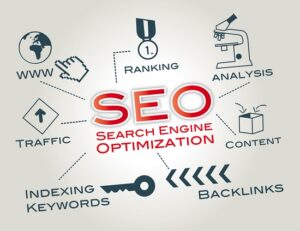 SEO, search engine optimization, or search optimization refers to the science and art of making pages to rank much higher on search engines like Google. Ranking higher in search engines can result in increased traffic to a website, since search is the most common way people find content online.
SEO, search engine optimization, or search optimization refers to the science and art of making pages to rank much higher on search engines like Google. Ranking higher in search engines can result in increased traffic to a website, since search is the most common way people find content online.
The results page in Google and other search engines often includes paid ads at the top. Next are the regular results, or what search marketers refer to as the “organic searches results”. To distinguish it from paid search traffic, traffic from SEO is sometimes called “organic search traffic”. Paid search is also known as search engine marketing (SEM), or pay-per click (PPC).
SEO: The benefits
SEO is an important part of online marketing, as search is the main way that users navigate the internet.
The order in which search results are displayed is important. The higher a site appears on the list, the more traffic it will receive. For example, the first result in a search query will receive between 40-60% and the third and fourth results significantly less. Only 2-3% click on the first page of search results. A small increase in search engine rankings could result in more traffic to a website and possibly more business.
Many website owners and businesses will attempt to manipulate search results so their site appears higher in the search results (SERP) than those of their competitors. SEO is the key to this.
How SEO works
Google and other search engines use an algorithm to decide which pages to show for a given query. These algorithms are complex and can take into consideration hundreds, if not thousands, of ranking factors in order to rank their SERPs. Search engines use three key metrics to determine the quality and rank of sites:
Link – Other websites’ links play an important role in ranking a site on Google and other search engines. A link can be viewed as a vote for quality by other websites since website owners won’t link to sites of low quality. Sites that have many links from other sites are considered authoritative (or “PageRank” by Google). This is especially true if they are linked to by search engines.
Content – Search engines analyze the content of webpages to determine if they are relevant to any particular search query. SEO involves creating content that targets keywords search engines users are looking for.
Page structure – This is the third component of SEO. The structure of a webpage’s HTML code can have a significant impact on how a search engine evaluates it. Site owners can improve their SEO by including relevant keywords in the title, URL and headers, as well as making sure that the website is easily crawlable.
Search engine optimization is the process of optimizing search engine algorithms to achieve higher search results rankings.
Search engine optimization techniques
Understanding the workings of search engines is just one step in the process of improving a site’s ranking in search results. To improve a site’s search ranking, you need to use various SEO techniques:
Keyword research – Keyword Research is often the first step in SEO. It involves looking at keywords that a particular website needs to rank for, as well as how its competitors would rank for them, and what keywords other potential customers may be looking for. The search terms used by searchers in Google and other search engines can help you determine what content needs to be optimized or created.
Content marketing – Once keywords are made known, content marketing could be used. This could be updating current content, or making new content. Google as well as other search engines place a premium on quality content. It’s crucial to find out what is available and create compelling content that offers a positive user experience. A good piece of content is more likely to be shared on social media or attract links.
Link building – Links from other websites (called “backlinks”, in SEO parlance), are one of the most important SEO levers. This could include promoting quality content, creating relationships with the webmasters and submitting sites to relevant directories.
On-page optimization – This is in addition to other factors like links. However, optimizing the structure of the page can provide tremendous SEO benefits. It is completely within the control of the webmaster. On-page optimization methods include updating the title tag to include keywords and using the alt attribute for images to be described. It can be beneficial to update a page’s meta tag (such as the description tag). These tags have no direct effect on search rankings but can improve click-through rates from the SERPs.
Site architecture optimization – Although external links are important for SEO, internal links (links within one’s website) also play an important role in SEO. A search engine optimization professional can help improve a site’s SEO by linking to key pages and making sure that anchor text is used in these links to improve the page’s relevance to specific terms. An XML sitemap is a great way to allow search engines to crawl larger pages.
 SEO professionals also use semantic markup optimization. Schema.org is a semantic markup that describes the meaning of the content on a website. It can help to identify the author of a piece or the type and topic of the content. Rich snippets can be displayed in search results pages using semantic markup. This includes extra text, review stars, and images. Although rich snippets within the SERPs don’t impact search rankings, they can increase CTR from searches, which in turn will lead to an increase in organic traffic.
SEO professionals also use semantic markup optimization. Schema.org is a semantic markup that describes the meaning of the content on a website. It can help to identify the author of a piece or the type and topic of the content. Rich snippets can be displayed in search results pages using semantic markup. This includes extra text, review stars, and images. Although rich snippets within the SERPs don’t impact search rankings, they can increase CTR from searches, which in turn will lead to an increase in organic traffic.
Top SEO tools
SEO is a technical discipline that requires many tools and software to optimize websites. Here are some of the most commonly used paid and free tools for small business marketing:
Google Search Console – Google Search Console, formerly “Google Webmaster Tools”, is a Google tool that is free and is part of the SEO’s standard toolkit. GSC can provide traffic reports and rankings for the top keywords and pages. It can also help to identify and fix technical problems on-site.
Google Ads Keyword Planner Keyword Planner is another tool that Google provides as part of its Google Ads product. Although it’s intended for paid search, it can still be useful for SEO as it offers keyword suggestions and keyword volume. This can be very helpful for keyword research.
Backlink analysis tools – There are many link analysis tools available, with the most popular being Majestic and AHREFs. Backlink analysis tools can be used to determine which websites link to your website or to those of their competitors. They can also be used to help you find new links in the process of link building.
SEO platforms – Many different platforms offer many of the tools needed to optimize websites. Moz, BrightEdge and Searchmetrics are some of the most well-known platforms. These platforms help you track keywords rankings, assist with keyword research, identify opportunities for on-page or off-page SEO, and perform many other tasks related SEO.
Social media – Although most social media sites have no direct SEO impact, they can be useful for building connections with other webmasters that could lead to guest posting and link building.
Optimizing search traffic: From clicks to conversions While search engine optimization can dramatically increase traffic to a website’s site, it won’t grow the business if the traffic doesn’t convert into paying customers. Conversion rate optimization (CRO), is the solution.
Optimization of conversion rates involves using A/B testing methods to modify websites and to measure their impact on the site’s conversion rate. Search marketers who are successful know that getting traffic to a website is only half the battle. What happens once the traffic arrives at the site is equally important.
Call Business Training Team if you want to know more about search engine optimization and small business marketing.
Business Training Team
Myrtle Beach, SC 29579
843-246-0136
https://www.businesstrainingteam.com/
